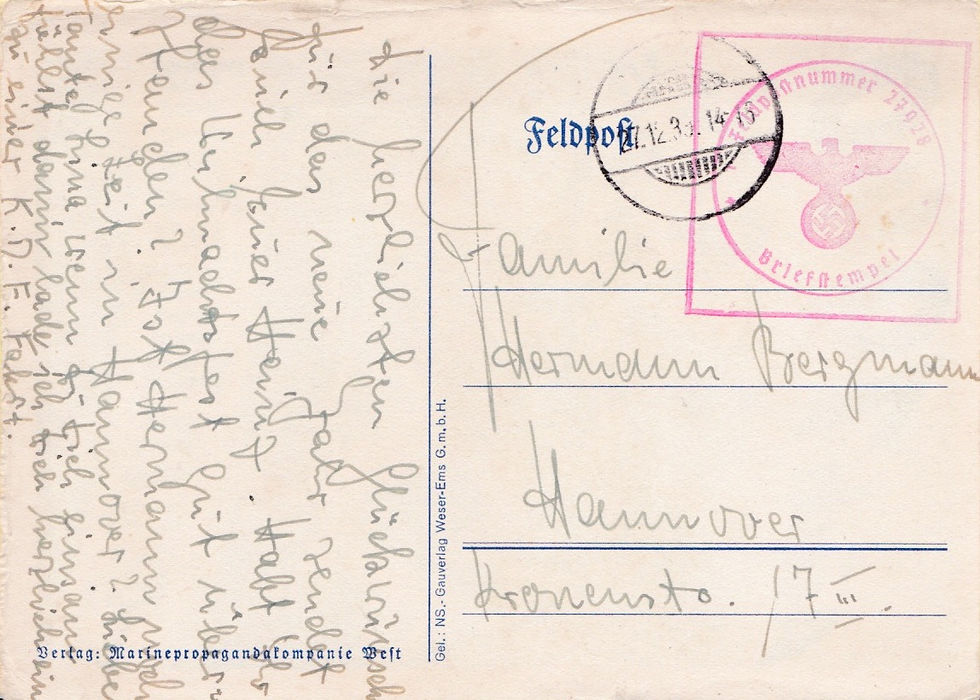27th December 1939



Propaganda postcard featuring an illustration by artist Harry Tress. The slogan translates to 'In 1940 full speed ahead against England', note that 'A.K.' is the abbreviation of 'äußerste Kraft', a naval term for full speed ahead. With feldpost cancel (Type 22) over a red feldpost number cachet (FPN 27928 - Minenschiff 'Kaiser'). Ref: 27.12.19
Story of the Kaiser


Extract from Wikipedia.de
The Kaiser was commissioned by the Nordsee-Linie Dampfschiffs-GmbH from the Stettiner Maschinenbau AG Vulcan in 1904. When HAPAG took over the North Sea Line on 1st January, 1905, it also bought the Kaiser , which was still under construction on the slipway, along with its three other ships – Cobra, Prinzessin Heinrich and Silvana . The launch took place on 8th April, with commissioning on 10th September, 1905. The Kaiser was in service from Hamburg - Helgoland and from there deployed to Sylt or Norderney. The travel time from the St. Pauli Landungsbrücken to Helgoland was around four and a half hours, and from there to Norderney another three hours. Kaiser Wilhelm II used the ship for occasional trips on the North Sea .
The Imperial Navy requisitioned the Kaiser on 4th August, 1914 and had her converted to an auxiliary mine ship (having the rear funnel removed). The ship could hold up to 200 mines. Under the command of Korvettenkapitän von Bülow, together with the mine cruisers SMS Albatross and SMS Nautilus, it laid a large mine barrier in the North Sea on September 9th September, 1914. However, the speed of the Kaiser proved to be too slow for a warship. At the end of the First World War she was the flagship for the flotilla 'Elbe' under commander Erich Graf von Zeppelin. In 1918 she was damaged by a mine and had to be made seaworthy again at a repair yard.
Following the German surrender the Kaiser was requistioned by Great Britain. However, it was not put into service there and was bought back by HAPAG on 23rd September, 192. In 1922 there was a conversion at the Bremer Vulkan shipbuilding and machine works in Vegesack. On 17th June, 1923, the British steamer Bellbro and the Kaiser collided below the Stör. The starboard side of the Kaiser was damaged above the waterline. One of 1,887 passengers was killed and four were seriously injured.
Initially back in service between Hamburg and Helgoland and to Amrum, Föhr and Sylt, the Kaiser sailed from 1st July, 1934, equipped with additional cabins, for the East Prussia sea service .
During the Second World War, the Kaiser was converted into a mine ship by the Kriegsmarine. It was armed with two 8.8 cm guns and could carry up to 180 mines. She was temporarily under the command of Carl Kircheiß and was used as a test ship by the Navy from 1943.
After the war, the Kaiser was once again given to Great Britain, from where she was handed over to the Soviet Union in 1946 and subsequently then to the People's Republic of Poland in April 1947. In 1949 (as the Beniowski) she became a training ship of the Polish Navy. The Beniowski was laid up in Gdynia from 1950 and served as a stationary training and accommodation ship in Stettin until she was demolished in 1954.
Contact Brief History to inform us of additional information regarding this page


